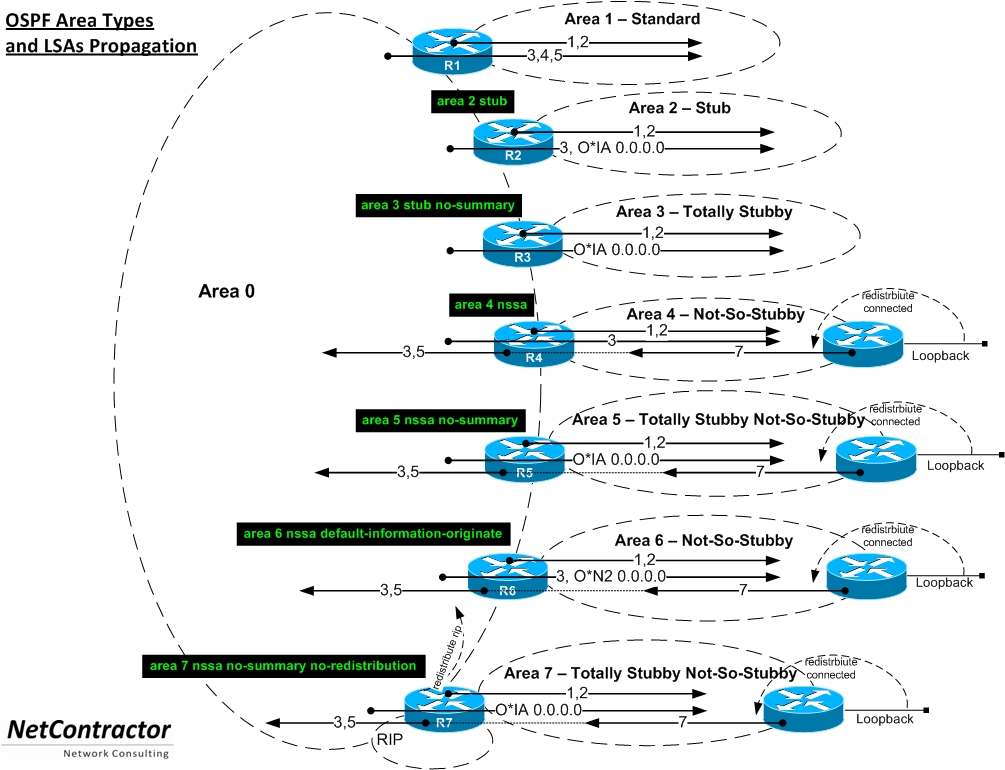OSPF Area Types:
[bodyads] OSPF is a widely used protocol in service provider environments. Now a days the majority of the network setups use this protocol. OSPF is well suited for multi-vendor environments. OSPF allows 5 different area types, which provides flexibility, fast convergence and scalability. OSPF area types are:
- Backbone/ Non-backbone
- Stub Area
- Totally Stubby Area
- Not-So-Stubby Area (NSSA)
- Totally Not-So-Stubby Area (NSSA)

Backbone area:
The backbone area is the core of an OSPF network (also this area known as area 0 or area 0.0.0.0). All other areas are connected to backbone area, and inter-area routing happens via routers connected to the backbone area and to their own associated areas. The backbone area is responsible for distributing routing information between non-backbone areas. The backbone must be contiguous, but it does not need to be physically contiguous; backbone connectivity can be established and maintained through the configuration of virtual links.
All OSPF areas must connect to the backbone area. This connection, however, can be through a virtual link. For example, assume area 0.0.0.1 has a physical connection to area 0.0.0.0. Further assume that area 0.0.0.2 has no direct connection to the backbone, but this area does have a connection to area 0.0.0.1. Area 0.0.0.2 can use a virtual link through the transit area 0.0.0.1 to reach the backbone. To be a transit area, an area has to have the transit attribute, so it cannot be stubby in any way.
Stub area:
Stub areas can contain type 1, 2, and 3 LSAs. A default route is substituted for external routes. Stub areas does not receive route advertisements external to the autonomous system (AS) and routing from within the area is based entirely on a default route. An ABR deletes type 4, 5 LSAs from internal routers, sends them a default route of 0.0.0.0 and turns itself into a default gateway. This reduces LSDB and routing table size for internal routers.
Totally stubby area:
Totally stubby areas can only contain type 1 and 2 LSAs, and a single type 3 LSA. The type 3 LSA describes a default route, substituted for all external and inter-area routes.A totally stubby area is similar to a stub area. However, this area does not allow summary routes in addition to not having external routes, that is, inter-area (IA) routes are not summarized into totally stubby areas. The only way for traffic to get routed outside of the area is a default route which is the only Type-3 LSA advertised into the area. When there is only one route out of the area, fewer routing decisions have to be made by the route processor, which lowers system resource utilization.

An area qualifies as stub or totally stubby when it meets the following criteria:
- There is a single exit point from that area.
- The area is not needed as a transit area for virtual links.
- No ASBR is internal to the stub area.
- The area is not the backbone area (Area 0).
All these criteria are important because a stub/totally stubby area is configured primarily to exclude external routes.
Not-so-stubby area (NSSA):
[adsense] A not-so-stubby area (NSSA) is a type of stub area that can import autonomous system external routes and send them to other areas, but still cannot receive AS-external routes from other areas.
NSSA is an extension of the stub area feature that allows the injection of external routes in a limited fashion into the stub area. The ASBR imports external addresses with a type 7 LSA,The ABR converts LSA type 7 into LSA type 5 before flooding them into the backbone (area 0), the ABR acts as an “ASBR” for other areas. The ABRs do not take type 5 LSAs and then convert to type 7 LSAs for the area.
Totally Not-So-Stubby Area (NSSA):
The totally stubby NSSA is an NSSA that takes on the attributes of a TSA, meaning that type 3 and 4 summary routes are not flooded into this type of area. It is also possible to declare an area both totally stubby and not-so-stubby, which means that the area will receive only the default route from area 0.0.0.0, but can also contain an autonomous system boundary router (ASBR) that accepts external routing information and injects it into the local area, and from the local area into area 0.0.0.0. Redistribution into an NSSA area creates a special type of LSA known as type 7, which can exist only in an NSSA area. An NSSA ASBR generates this LSA, and an NSSA ABR router translates it into type 5 LSA which gets propagated into the OSPF domain.
By declaring the totally stubby area as NSSA, no external routes from the backbone, except the default route, enter the area being discussed. The externals do reach area 0.0.0.0 via the TSA-NSSA, but no routes other than the default route enter the TSA-NSSA. Routers in the TSA-NSSA send all traffic to the ABR, except to routes advertised by the ASBR.


